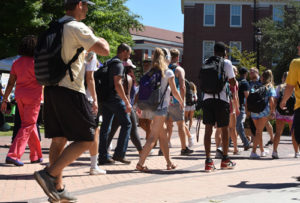Many students felt their educational experience suffered during COVID-19 when campuses shut down and when learning moved online, according to a number of surveys–and now, many seem to want to return to campus.
An April survey by OneClass shows that 75 percent of students did not feel they were receiving a high-quality online learning experience from their college or university.
The sentiment arose from abrupt closures, use of unfamiliar platforms by students and teachers, students struggling to balance new responsibilities or stress brought on by the pandemic, and more.
Related content: COVID-19 is creating a new education reality
Now, a return to a socially-distanced campus might be the solution to frustrations. A OneClass poll of 6,050 parents in 27 different college and university Facebook groups reveals that 80 percent of parents say “yes, absolutely,” when asked if they’re comfortable with their children returning to campus with social distancing regulations in place.
Nearly 8 percent of parents (7.9 percent) say they don’t believe social distancing will be necessary in the fall, 5.2 percent believe online learning should continue until 20201, and 6.7 percent say they’re comfortable with their children returning, but a physical return to campus should be voluntary.
Responses from parents at a few colleges stood out in how they different from overall parent responses, according to a blog post dissecting the survey.
More than half of the University of Mississippi parents surveyed say social distancing won’t be needed this fall–58.3 percent, compared to 7.9 percent of all respondents.
By contrast, 16.9 percent of parents at Cornell University say online learning should continue through 2021–much higher than the 5.2 percent of total respondents who said the same.
Parents of University of Michigan-Ann Arbor say returning to classes on campus should be voluntary–18.9 percent compared to 6.7 percent of all respondents.
What, exactly will social distancing look like on campuses? Aside from hand washing, face masks, and hand sanitizer, there are a number of different scenarios, many of which focus on reducing the number of people on campus.
Lecture hall classes may remain online, while classes with in-person needs such as labs, studio classes, or those requiring equipment would occur on campus. In another scenario, only certain groups of students, such as freshman or seniors, might be present on campus for classes.
Models that predict what campuses may look like without social distancing, such as one laid out by former Yale University president Richard Levin, paint an alarming picture.
If 1,000 students arrive on campus in the fall and one has COVID-19, 85 percent of students will have become infected before December 18 if there is no social distancing and assuming students have no immunity.
But with social distancing practiced 50 percent of the time, only 0.9 percent of the population will be infected by that same time. If social distancing is practiced 60 percent of the time, the infection rate drops to 0.2 percent in four months.
- First-generation students are more likely to seriously consider leaving college - April 17, 2024
- How higher ed can meet workforce needs - April 15, 2024
- Higher ed leaders believe continuing education units are undervalued - April 10, 2024

